NEET Biology Kingdom Fungi Features Of Fungi
This division comprises more than 100,000 species of fungi and has representation in almost every available habitat on earth and many fungi are of major economic or medical significance to man.
- They are composed of moulds, yeast, mushrooms, puffballs and toadstools.
- Fungi are found in almost all types of habitats. Many species of phycomycetes are found in water and are called aquatic fungi.
- Fungi are well adapted to the environment and nutrition. They grow in a wide range of temperatures and pH.
- Psychrophilic fungi grow at and below freezing point while thermophilic fungi remain viable even at 62°C.
- Most of the fungi grow well in acidic pH between 5 — 6-5 pH. Light is generally not essential for the growth of fungi.
- The fungi are achlorophyllous non-vascular thallophytes.
- Their mode of nutrition is either saprophytic, parasitic or symbiotic.
- 5 Fungi are dimorphic. Some pathogenic fungi of humans and other animals have a unicellular and yeast-like form in their hosts but when they grow saprobically in the soil they have filamentous bodies Example Blastomyces dermatitis.
- The thallus is very simple and may be unicellular (yeast ) or consists of a network of hyphae called mycelium. The mycelium may be aseptate and coenocytic (Rhizopus) or septate as in Penicillium, Agaricus etc.
- The reserve food material is in the form of glycogen and oil droplets.
- Their mode of reproduction is vegetative by fragmentation, and asexual by formation of conidia, oidia, zoospores and chlamydospores.
- Sexual reproduction is oogamous in lower forms (Phycomycetes, Ascomycetes), by somatogamy in higher forms (Basidiomycetes) and is absent in deuteromycetes. So fungi show a reduction in sexuality.
Read and Learn More NEET Biology Notes
Characteristics Of Fungi NEET
Sexual reproduction transpires through isogamy, anisogamy, heterogamy, gametangial contact, gametangial copulation, spermatization, and somatogamy. Somatogamy can be classified as pseudogamous, monogamous, or adelphogamous.
Three mycelial phases exist—dikaryotic, diploid, and haploid—due to distinct nuclear processes: plasmogamy, karyogamy, and meiosis.
NEET Biology Kingdom Fungi Classification Of Fungi
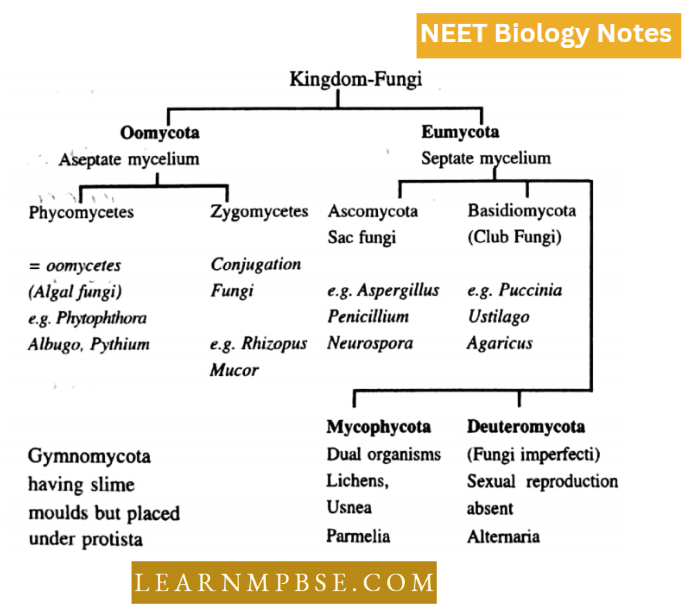
NEET Biology Kingdom Fungi Oomycota
This group includes fungi with aseptate mycelium. These are lower fungi. This group is further divided into phycomycetes and zygomycetes. Phycomyceles. = Oomycetes = Algal fungi = Egg fungi.
They are popularly called algal fungi because they bear a striking resemblance to some algae ( Vaucheria) in the morphology of the thallus. The thallus ranges from unicellular to a profusely branched filamentous mycelium which is coenocytic.
Asexual reproduction takes place by sporangiospores equivalent to conidia often called conidiosporangia. Sexual reproduction is mainly by gametangia contact when present is isogamous or heterogamous.
Karyogamy generally follows plasmogamy so there is no dikaryophase in the life cycle. Common examples are black moulds, pink moulds, white rust, Phytophthora and downy mildews. Zygomycetes (conjugation fungi)
- These are saprophytic or parasitic fungi and can be grown on a culture medium.
- During life history a diploid resting spore called zygospore is produced by conjugation, hence the name of the group is zygomycetes.
- Mycelium is coenocytic.
- Hyphae are non-septate and haploid.
- Hyphae produce aerial branches called sporangiophores bearing sporangia at the tip of hyphae which produces non-motile spores.
1. Squinting Fungus.
Pilobolus crystallinus is a coprophilous or dung mould.
2. Rhizopus and Mucor.
Bread Mould (Rhizopus stolonifer) Rhizopus is a saprophytic fungus. Mycelium is made up of rhizoidal hyphae meant for attachment and absorption of food and water, stoloniferous hyphae which bear at nodes vertically a group of aerial hyphae called sporangiophores.
Hyphae are aseptate and coenocytic. It has many nuclei and reserves food in the form of oil and glycogen.
- The life cycle is of Haplontic type.
- Vegetative reproduction by fragmentation.
- Asexual reproduction. Under favourable conditions, sporangia is borne on sporangiophores.
Each sporangium has a central dome-shaped columella and many multinucleate sporangiospores. Sporangiospore on dispersal to other substratum again produces new mycelium.
Characteristics Of Fungi NEET
Sexual reproduction. It occurs at the end of the growing season under unfavourable conditions. Sexual reproduction employs the conjugation of two gametangia resulting in the formation of azygospore.
Zygospore (2N) is the only diploid structure zygospore wall breaks so there is the formation of promycelium. Then a germ sporangium develops at the tip of the promycelium. This germ sporangium develops uninucleate haploid meiospores known as germ spores. So life cycle is haplontic.

NEET Biology Kingdom Fungi Eumycota
Ascomycetes. They are also called Sac fungi characterised by the presence of ascus in which usually 8 ascospores are produced. Many asci are grouped to form a fructification called ascocarp which is of 4 types viz.
Cleistothecium (closed ) Example Penicillium
Apothecium ( open cup-shaped ) Example Peziza and
Perithecium (flask-shaped) with pore called ostiole Example Clavicepspurpurea.
Ascostroma – cushion-like and chambered, locules separated by stroma and having asci. Yeast ( Saccharomyces cerevisiae).
It is commonly employed in bread making and beer brewing and is also called brewer’s or baker’s yeast. It is unicellular ascomycetes.
It consists of a mass of protoplast surrounded by a cell wall. The protoplast has stored foods in the form of glycogen, fat and volutin granules.
The nucleus is situated on one side of the vacuole. Asexual reproduction is by budding and fission Example A small protuberance arises which gradually increases in size.
It is known as bud. Meanwhile, the nucleus of the mother cell divides mitotically and migrates into an enlarged bud.
In this way, a large number, of buds are formed in a chain. Sexual reproduction is by conjugation of two yeast cells.
Yeast may be homothallic or heterothallic. The diploid cell may multiply by budding or it may produce ascospores. There are two stages, haploid and diploid which regularly alternate with each other.
So in Saccharomyces cerevisiae, the life cycle is the haplodiplontic type and haplontic in Schizosaccharomyces homosporous and diplontic Example Saccharomycodes Ludwig. Yeasts are used in baking, as food and in the alcohol industry.
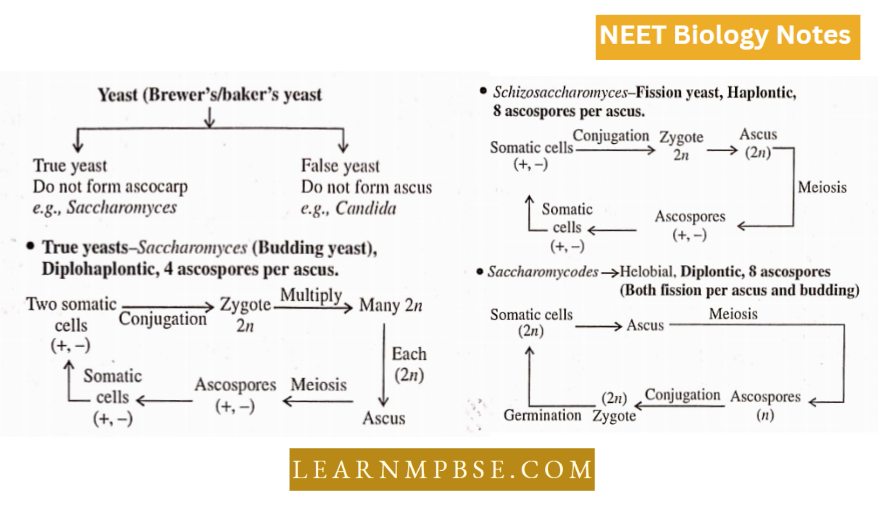
Basidiomycetes. These are also called club fungi (due to Basidium) characterised by the presence of complicated fruiting bodies called basidiocarps. They bear reproductive structures called basidia.
Each basidium produces four basidiospores exogenously. The common examples are the smuts, rusts, the toadstools and puffballs. Mushroom.
Agaricus campestris is the most common form of mushroom which being edible is also cultivated. In Punjab, it is called Dhingari. Basidiospores are produced in a reproductive structure called basidiocarp which is differentiated into a stalk called a stipe and a cap-like structure called pileus.
Basidiospores germinate to form primary mycelium which is of short duration.
Then there is somatogamy in two different strains resulting in the formation of dikaryotic mycelium. On the mycelium are produced ring fruiting bodies (basidiocarps) also called fairy rings.
In each basidiocarp are produced club-shaped basidia in hymenium layers of gills which are present in pileus. Gills bear numerous basidia and paraphyses. Each basidium is club-shaped and produces four basidiospores exogenously, basidiospores are borne on stalk-like structures called sterigmata.
Kingdom Fungi NEET Question Bank
Basidiospores on dispersal again produce haploid or monokaryotic primary mycelium. Thus completing the life cycle in which there is a monokaryotic phase (primary mycelium) eukaryotic phase, and diplophase (only represented by basidium). Deuteromycetes.
These are also called “ Fungi Imperfecti” as the sexual stage is not found. The conidial stage is similar to the conidial stage of ascomycetes.
The fungi of this class cause many diseases of plants Example Colletotrichumfalcatum causes red rot of sugarcane. Deuteromycetes, Helminthosporium, Alternarici, Fusarium.
NEET Biology Kingdom Fungi Useful Terms
Clamp Connection. It is a small looped hypha which develops at the time of cell division and septa formation in the dikaryon of basidiomycetous fungus.
Cleistothecium. Closed ascocarp is termed cleistothecium. Eucarpic. When only a part of the thallus is used for the formation of reproductive bodies.
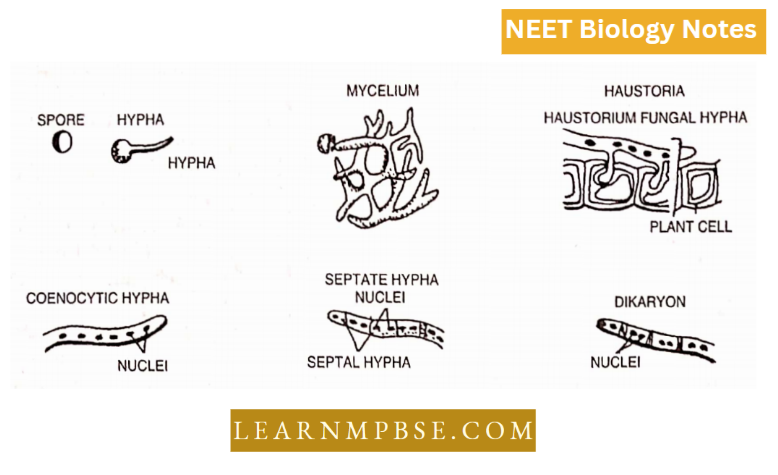
Holocarpic. Cells which is completely converted into reproductive structures. Dolipore septum. It is a complex pore in the septum of the hypha of a basidiomycetous fungus.
Diplanctism. The successive production of two different types of zoospores by a single fungal organism is termed as diplanetism Example Saprolegnia.
Mycobiont. Fungus partner of lichen. Parasexuality.
It was first reported by Pontecarvo and Roper in 1952 in Aspergillus nidulans and the imperfect stage of Einericella nidulans. Some fungi have genetic recombination of a type which is different from the normal sexual type. This other than sexual mode of reproduction is called parasexuality.
Predaceous fungi. These are animal trapping Examples Dactylella, and Arthrobotrys (belong to deuteromycetes). They capture small insects such as eelworms, rotifers, and protozoans and use them as food Rust. Fungal genera of Uredinales cause dark spots on the stems and leaves of hosts, for example, Puccinia.
Smut. Fungal genera of Ustilaginales produce a large number of black dusty spores (chlamydospores), ExampleUstilago.
Zygospores. These are thick-walled spores of zygomycetous fungi formed after the fusion of two gametangia.
Plectenchyma. When the mycelium gets organised into loosely or compacdy woven tissue-like structures.
Pseudoparenchyma. Mycelium in which the hyphae are very closely packed to lose their identity.
Perithecium A type of ascocarp which is flask-shaped and bears a pore through which ascospores are discharged, for Example, neurospora or cells. Somatogamy Fusion of two somatic hyphae.
Heterothallism. It was discovered by A.I. Blakeslee. He found two types of species in Mucorales and designated them as homothallic and heterothallic types.
In homothallic species, a zygospore is formed by conjugation of hyphae produced from a single mycelium Example R.sexualis. In the heterothallic species Example, R. stolonifer zygospore is not formed if two hyphae are produced from a single mycelium.
In these species, sexual union occurs only between two different mycelia considered as (+) and (-) strains. (+) and (-) strains are alike morphologically but differ physiologically. This is known as heterothallism.
The heterothallism may be morphological or physiological. Heterothallic fungi may be bipolar or tetrapolar. In bipolar species, there is only one pair of compatibility factors whereas in tetrapolar species there are two pairs of genetic factors.
Heterothalism is a device to prevent inbreeding and promote outbreeding. The haploid fungi reproduce asexually by producing a large number of mitospores. These spores germinate and give rise to new individuals.
All these individuals are genetically identical as they are formed from the same parent fungus by mitosis.
Kingdom Fungi Classification NEET
Sexual reproduction involves the fusion of gametes and meiosis. Homothallic species reproduce sexually by fusion of gametes produced from two gametangia having almost similar genetic constituents (i.e., inbreeding) and, therefore, have fewer chances of genetic variation among the offspring.
Heterothallic species, on the other hand, ensure a combination of two gametes belonging to genetically different individuals (i.e., outbreeding) which results in greater genetic variation among the offspring so that they can withstand abnormal environmental conditions and adapt themselves in different substrata. Therefore, heterothallism is a device to prevent inbreeding and promote outbreeding.
NEET Biology Kingdom Fungi Economic Importance Of Fung
- As Food, Yeast is used because it contains about 50% protein. Yeast protein is called single-cell protein.
- Agaricus bisporous, Volvaria and Lentinus elodus are some edible mushrooms.
- Research Tools. Neurospora and Physarum are used in several genetics and biochemistry experiments.
- Antibiotics. Penicillin ( from Penicillium nolatum and P. chrysogenum), and griseofulvin ( from Penicillium griseofulvum), are some antibiotics obtained from fungi).
- Acids. Several organic acids are produced from species of Rliizopus, Aspergillus, Mucor, etc.
- Hormones. Gibberellin is obtained from Giberellafujikuroi.
- Vitamins. Saccharomyces cerevisiae and other yeasts are good sources of vitamin B- ) complex and riboflavin.
- Spoilage of food grains. Rliizopus, Mucor, Aspergillus, Penicillium, etc. are spoiling agents of food grains, fruits etc.
- Poisonous fungi. Amanita phalloides, A. verna and Boletus satavus are highly poisonous fungi. Coprinus, Psilocybe and Incocybe are also poisonous. Amanitaphalloides is called “Death cup”.
- Some fungi are extremely poisonous. For example- Amanita phalloides (death cup) produces poisonous toxins like a-amanitin, phalloidin, etc., which stop the synthesis of mRNA.
- Sclerotia of the fungus Claviceps purpurea contains many poisonous alkaloids which cause poisoning in human beings. The acute condition of such poisoning is called ‘St. Anthony’s fire’, Helvetia (saddle fungus) is a poisonous cup fungus and can be fatal if consumed.
- Toxins and aflatoxins. Amanitaphalloides, A. vema, Clavicepspurpurea, Aspergillus flavus, etc. produce toxins and aflatoxins.
- Some fungi contaminate our food and secrete toxins. These toxins are called mycotoxins. They are very harmful and cause illness when such contaminated food is consumed. Some of the important mycotoxins are.
- Aflatoxins are produced by Aspergillusflavus and related strains. Some of these are carcinogenic.
- Amatoxins and Phallotoxins are produced by the mushroom- Amanita phalloides (death cup).
- Coprine is produced by the edible mushroom Coprinus atramentanius.
- Ochratoxins are produced by Aspergillus ochraceus and Penicillium viridicatum.
- Trichothecenes are produced by species of Fusarium, Cephalosporium, Trichoderma, etc.
- Zearalenone is produced by species of Fusarium.
- Hallucinogenic drugs. Psilocybe mexicana, Amanita in sharia, Incocybe, etc. are some fungi which produce some hallucinogenic drugs, responsible for nausea, vomiting, diarrhoea, and even death. LSD is obtained from fungus, Claviceps purpurea.
- Lichens used in medicines. Jaundice, hydrophobia, lung diseases.
- Lichens as a source of dyes
- Other uses
- Nitrogen fixation by yeasts like Saccharomyces and Rhodotorula
- Production of latex by Mycena galopus.
- Soil building by Rhizopus, Cladosporium, Aspergillus etc.
- Along with bacteria, fungi work as decomposers.
- Biological control of growth of hyperparasites like insects, nematodes, bacteria and even other fungi.
- Neurospora is good research material for geneticists and Physarum for molecular biologists for the study of DNA.
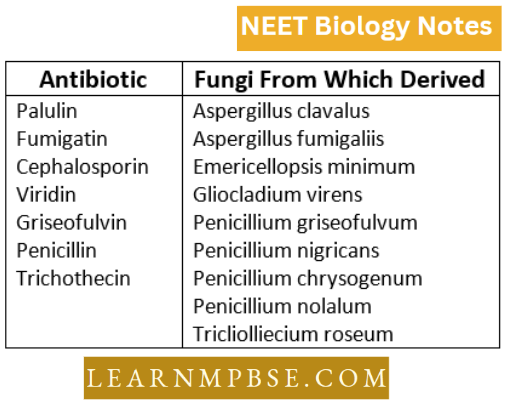
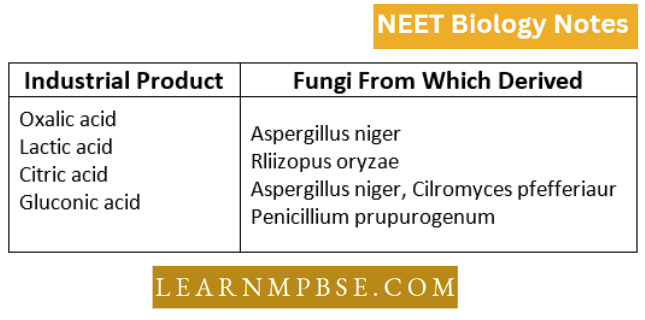
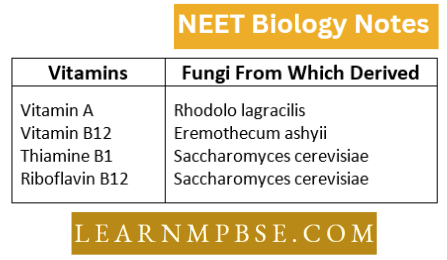

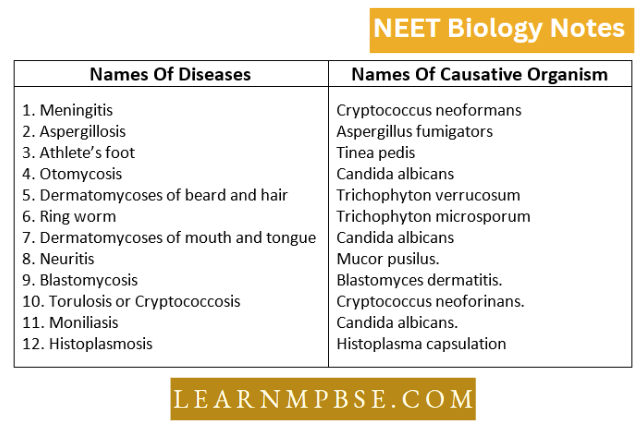
NEET Biology Kingdom Fungi Lichens
Lichens are a distinct assemblage of intriguing organisms that coexist with mosses on tree trunks and rocks. Lichen is a symbiotic relationship between a fungus and an alga.
- The fungal element is referred to as mycobiont, whereas the algal element is termed phycobiont.
- Lichen is a symbiotic relationship between algae and fungi, with the algae potentially being blue-green or green in color.
- Algae synthesize food from carbon dioxide and water, whereas fungi assimilate water and minerals.
- Lichens are fundamentally categorized into three types: Crustose lichens. The thallus is planar and creates a crust on rock, exemplified by Graphic scripta, Haemotoma puniceum, Lecanora, and Rhizocarpon.
- Foliose lichens are broad and leaf-like, exhibiting lobed structures; examples include Parmelia, Xanthoria, and Physcia. Fruticose lichens.
- They exhibit extensive branching akin to shrubs and are affixed to the substrate via a disc. The branches produce reproductive structures known as apothecia. Usnea, Cladonia exemplars.
- Asexual reproduction occurs by the use of soredia. Lichens serve as markers of atmospheric pollution.
- Certain lichens are used in pharmaceuticals and as sustenance. Lichens are crucial in soil formation, facilitating succession on a rock known as xerosere.
Old Classification of Lichens based on Habitat
- Terricolous —Growing on soil Example Lecidea, Cladonia.Floerkeana
- Saxiscolous —Growing on rocky substrata Examples Dermatocarpon, Porina, Xanthoria
- Corticolous—Growing on wood bark Example Usnea, Parmelia.
- Lignicolous — Developing on wood Example Cyphelium
NEET Biology Kingdom Fungi Economic Importance Of Lichens
- Beneficial Activities
- Early colonizer. Lichens are the pioneers of plant growth on bare rocks and are called first colonizers.
- Soil builder.
- The lichens are pioneers of vegetation in a lithosere ( succession on rocky surface). They bring about the biological weathering of rocks by forming acids such as carbonic acid, oxalic acid, etc., which leads to soil formation.
- Food.
- Some lichens are a valuable source of food for wild animals and cattle.
- Cladonia rangiferina growing to a height of about 30 cm, in the arctic regions, serves as food for Reindeer, hence called ‘reindeer-moss’.
- Certaria islandica is used as a food article in Iceland (hence called ‘Iceland moss’), Sweden and Norway.
- Lecanora esculenta is used as food in Israel.
- Enocarpon miniatum is used as a vegetable in Japan.
- Umblicaria esculenta is used as food in Japan.
- Parmelia, generally called rathapu in Telugu is used as a spice in curry (curry powder ) in South India and it is also used as a food, as well as in making chocolates and pastries.
- Species of Stereocaulon and Evemia are also used as fodder.
- Medicinal uses
- Cladonia pyxidata is used in the treatment of whooping cough.
- Pannelia permata is used in the treatment of snakebites.
- Parmelia sexatilis is used in the treatment of epilepsy.
- Lobaria purmelia is used in the treatment of lung diseases.
- Evemia and Usnea are used in the treatment of haemorrhage
- Usnea barbata is used in the treatment of urinary diseases.
- Some species of Usnea and Cladonia are used to extract an antibiotic called usnic acid which has antibacterial activity and has proved very effective against tuberculosis when used in combination with streptomycin.
- Peltigera and Black pepper are used in the treatment of rabies.
- Peltigera canina is used in the treatment of hydrophobia and liver ailments.
- Cetraria islandica is used in the treatment of diabetes and respiratory diseases.
- Rocella montagnei is used in the treatment of angina.
- Cladonia, Rocella and Evemia are used in controlling different types of fevers.
- The protolichesterinic acid obtained from some lichens has anticarcinogenic properties.
- Industrial uses
- The lichens contain carbohydrates in the form of lichenin. Hence, they are used in producing alcohol in countries like Sweden and Russia.
- Species of Evemia, Pseudomia, and Ramalina contain essential oils and hence they are used in the manufacture of soaps and perfumes. Besides, they also contain chemicals like geraniol, naphthalene, etc.
- A red dye is obtained from the Ochrolechia species.
- A brown dye is obtained from Parmelia species.
- A dye orchill is prepared from Rocella tinctoria.
- Another brilliant colouring dye is, cud-bear obtained from lichen species.
- Litmus used as an acid-base indicator is obtained from Rocella Montagne and Lasallia pustulate.
- Indicator of air pollution. Lichens act as an indicator of air pollution because no lichen can be found in areas of heavy industrial pollution. After all, lichens are sensitive to S02.
- Njfixation. Lichens having blue-green algae are important in fixing nitrogen.
- Chemicals. Some lichen yields important chemicals. For example:
- Ramalina siliquosa yield salzinic acid.
- Parmelia subtrudecta yield lecanoric acid.
- Cladonia crispate yields squamatic acid.
- Religious importance. Sweet-scented thalli of lichens like Evemia and Ramalina are used in the preparation of ‘ dhup’ and ‘hawan samagris’.
Kingdom Fungi Classification NEET
Harmful Activities
- Damaging buildings. In humid areas, lichen can grow on window panes, marble and cement damaging the building by their etching activity.
- Poisonous. Some lichens are poisonous, such as Letharia vulpina due to vulpinic acid, Cetraria juniperina due to pinastrinic acid, Parmelia molluscum due to selenium, Xanthoria parietina due to beryllium and Evemiafutjuracea due to chlorine.
- In deuteromycetes or fungi imperfectii sexual reproduction is absent or yet to be discovered.
- A few important members of Deuteromycetes are :
- Colletotrichumfalcatum causes red rot of sugarcane.
- Helminthosporium oryzae causes brown leaf spot disease in rice.
- Altemaria solani causes early blight disease of potato and tomato.
- Cercospora personata causing tikka disease.
- Fusarium oxysporium causing wilt disease.
- Fusarium moniliforma causes balance disease of rice and releases gibberellins.
- Fungal tissue is called plectenchyma which is formed due to well-organised hyphae either forming parallel called prosenchyma or giving the appearance of parenchyma of higher plants called pseudoparenchyma.
- In liquid media, particularly in the presence of a high concentration of sugar the hyphae become segmented like in yeast called as torula stage.
- Aflatoxins, a type of mycotoxin was discovered in 1961 in Aspergillusflavin and later on in many other members.
- Morchella is morel or sponge mushroom and is highly-priced for their delicacies.
- In 1845-1860 a million people died in Ireland alone due to the destruction of potato crops by Phytophthora infestans. This famine led to the discovery of plant pathology.
- Most parasitic fungi are autoecious except rust. Puccinia is heteroecious as it requires two hosts after its life cycle, i.e. wheat (primary host) and barberry. (secondary host).
- Thiamine (Vit. B) produced by Saccharomyces cerevisiae Riboflavin by Saccharomyces cerevisiae Vit B12 Eremothecum ashbyic YitaminsPhodatarala gracilis Keratimophilic Fungio Grown on nails, feathers, hairs, hoofs.
- Fungi growing on
- Tree bark = Carticolous
- Dungwood = Cophoprhilous
- Burnt wood = ep xylic and xerophilous
- “Lomasomes” or “plasmoalemmasomes” are some membranous structures found in between the plasmalemma and cell wall of some fungi. Chlorophyll is absent in all fungi.
- Yeast is also called sugar fungus or Zuckerpilz. Neurospora crassa was regarded as Drosophila of the plant kingdom.
- Largest fungus. Giant puffball Parmelia lichen is called Rock flower. Cladonia is known as Reindeer moss. Pethigera is called dog lichen.
- Coprinus comatus (Basidiomycetes) fungus is used in making ink (from gills). So it is called an Inky Cap mushroom.
- In fungi vesicular structures that develop from cell membranes are called lomasomes. They are found in between the cell wall and cell membrane and help in the elaboration of the cell wall.
- Some fungi emit light and are called luminescent fungi. These fungi have luciferase enzyme which acts on luciferin in the presence of oxygen, for example, Xylaria hypoxylon, Panus sp, and Arrnillaria mallet. Fossil fungi are Mucarites combrensis, Agarites wardens, and Penicillites curtipes.
- The fungi which grow in trees are called lignicolous fungi Example Polyporus, and Trametes.
- Heterothallism was discovered by Blakeslee in the species of Mucor. It refers to the sexual union between hyphae of opposite strains. Homothallic mycelia are self-fertile.
NEET Biology Kingdom Fungi Quanta to Memory
- The fungi which grow on dung are called Coprophilous fungi eg. Mucor media, Pilaria, and Pilobolus.
- Famous Irish Famine caused by: Late blight of potato Fungus Phallus unpicks is a member of Basidiomycetes is a dead man’s finger.
- Hydnum is a member of articles called tooth fungus.
- In Deuteromycetes Parasexuality is an alternative method of sexual reproduction
- Phycomycetes are called algal fungi or lower fungi.
- The torula stage is the budding of oidia in a sugary solution.
- About 2300 antibiotics have been discovered so far from various fungi. Of these, some 123 have been extracted from Penicillium and 115 from Aspergillus.
- The best work on fungi produced so far is ‘Silloge Fungorum’ by Saccardo. The work on Puccinia, Penicillium and Neurospora aroused interest in this branch.
- Several mycotoxins (aflatoxins, zearalenone, ochratoxins, trichothecenes) are produced by fungi.
- Many forms (For example, Amanita phalloids) are poisonous.
- Cleviceps purpurea causes ergotism. It also yields a hallucinogenic drug called L. S. D. Rotting of wood (Polyporss, Fomes, Ganoderma), allergies (Mucor, Aspergillus etc.) deterioration of articles (Cladisporium, Altemaria, Chaetomium) is caused by many forms.
- Several forms are eaten as food Example, Agaricus and Morchella. Yeast cakes, incaparina, SCP etc. are edible products obtained from yeasts. Penicillium sp. is used for flavouring cheese. Yeasts are used in brewing and baking.
- Aspergillus causes Aspergillosis in human beings. A pheromone is a substance secreted to the outside by an individual and received by a second individual of the same species in which it induces a specific reaction Example a definite behaviour i.e. fusion of two yeast cells during sexual reproduction.
NEET Biology Kingdom Fungi Questions For Competitive Examinations
Question 1. Which one of the following is a harmful lichen?
- Umbilicaria
- Letharia
- Usnea
- Caledonia.
Answer: 2. Letharia
Question 2. Mycorrhizal association occurs in pinus, ficus and :
- Utricularia
- Legumes
- Eucalyptus
- Azadirachta.
Answer: 3. Eucalyptus
Question 3. The collateral host is:
- Additional host
- Host in which life cycle is completed
- Alternate host
- Infected host.
Answer: 1. Additional host
Question 4. Sexual reproduction is absent in :
- Deuteromycetes
- Phycomycetes
- Ascomycetes
- Basidiomycetes.
Answer: 1. Deuteromycetes
Fungi Examples NEET
Question 5. In an ascus of ascomycetes, the number and arrangement of ascospores are:
- 8 In linear order
- 4 In linear order
- Both a and b
- 8 Or 4, linear order or unordered.
Answer: 4. 8 Or 4, linear order or unordered.
Question 6. Mycelium of mucor/rhizopus is :
- Aseptate and unicellular
- Septate and unicellular
- Septate and multicellular
- Coenocytic.
Answer: 4. Coenocytic.
Question 7. Fungi are always:
- Heterotrophs
- Saprophytes
- Parasites
- Autotrophs.
Answer: 1. Heterotrophs
Question 8. Which of the following produces aflatoxin?
- Viruses
- Bacteria
- Fungi
- Nematodes.
Answer: 3. Fungi
Question 9. An example of an obligate anaerobe is :
- Clostridium
- Hiv
- Aspergillus sp
- Penicillium notatum
Answer: 1. Clostridium
Question 10. An adhesive pad of fungi penetrates the host with the help of:
- Mechanical pressure and enzymes
- Hooks and suckers
- Softening by enzymes
- Only by mechanical pressure.
Answer: 1. Mechanical pressure and enzymes
Question 11. One of the following attacks inflorescence and grains equally :
- Loose smut of wheat
- Covered smut of barley
- Com smut
- Late blight of potato.
Answer: 1. Loose smut of wheat
Question 12. Which of the following fungi releases mycotoxin in stored rice grains?
- Aspergillus
- Altemaria
- Fusariurn moniliforme
- Penicillium.
Answer: 1. Aspergillus
Question 13. Match the disease and causative agent
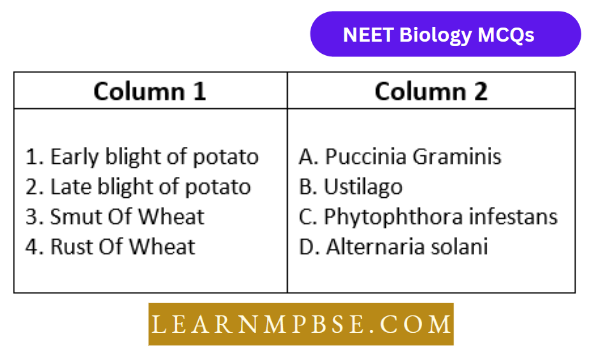
- A-1,B-2,3-3,4-4
- A-4,B-3,3-2,4-1
- A-2,B-3,3-4,4-1
- A-4,B-2,3-1,4-1
Answer: 2. A-4,B-3,3-2,4-1
Question 15. Lichen growing on wood is called :
- Saxicolous
- Terricolous
- Corticolous
- Lignocolous.
Answer: 4. Lignocolous.
Question 16. A fungal filament system is known as mycelium, but pseudo mycelium is formed in:
- Yeast
- Rhizopus
- Aspergillus
- Synchytrium.
Answer: 1. Yeast
Question 17. The causal agent of red rot of sugarcane is
- Helminthosporium
- Fusarium
- Pythium
- Colletotrichlim.
Answer: 4. Colletotrichlim.
Reproduction In Fungi NEET
Question 18. White rust of crucifers is :
- Puccinia graminis
- Ustilago tritici
- Albugo candida
- Aspergillus flavus
Answer: 3. Albugo candida
Question 19. Among rust, smut and mushrooms all three :
- Are pathogens
- Are saprobes
- Bear ascocarps
- Bear basidiocarps.
Answer: 1. Are pathogens
Question 20. Which of the following environmental conditions are essential for optimum growth of mucor on a piece of bread?
- Temperature of about 25°c
- Temperature of about 5°c
- Relative humidity of about 5%.
- Relative humidity of about 95%
- A shady place
- A brightly illuminated place
Choose the answer from the following options :
- 2, 2 and 5 only
- 2, 3 and 6 only
- 1, 3 and 5 only
- 1, 4 and 5 only.
Answer: 4. 1, 4 and 5 only.
Question 21. Yeast and algae are the main sources of
- Vitamin b complex
- Vitamin c
- Minerals
- Vitamin k.
Answer: 2. Vitamin c
Question 22. Red rot of sugarcane and white rust of radish are respectively caused by:
- Albugo candida and cercospora
- Colletotrichum and fusarium 28.
- Pythium and phytophthora
- Albugo candida and puccinia graminis
- Colletotrichum and albugo candida
Answer: 5. Colletotrichum and Albugo candida
Question 23. Azolla increases soil fertility of:
- Maize
- Barley
- Rice
- Wheat.
Answer: 3. Rice
Question 24. Identify from the following examples, a fungus which is of medicinal importance.
- Agaricus
- Saccharomyces
- Penicillium
- Cercospora.
Answer: 3. Pehicillium
Reproduction In Fungi NEET
Question 25. Which pair of the following belongs to basidiomy- cetes?
- Pufballs and claviceps
- Peziza and stinkhorns
- Morchella and mushrooms
- Birds’ nest fungi and puffballs.
Answer: 4. Birds’ nest fungi and puffballs.
Question 26. Ergot of rye is caused by a species of:
- Uncinula
- Ustilago
- Claviceps
- Phytophthora.
Answer: 3. Claviceps
Question 27. Deuteromycetes are called imperfect fungi due to :
- Lack of cell wall
- Lack of sexual reproduction
- Lack of asexual reproduction
- Lack of vacuoles.
Answer: 2. Lack of sexual reproduction
Question 28. Select the wrong statement:
- Anisogametes differ either in structure, function or behaviour
- In oomycetes female gamete is smaller and motile, while the male gamete is larger and non-motile
- Chlamydomonas exhibits both isogamy and anisogamy and the focus shows oogamy
- Isogametes are similar in structure, function and behaviour.
Answer: 2. In oomycetes female gamete is smaller and motile, while the male gamete is larger and non-motile
